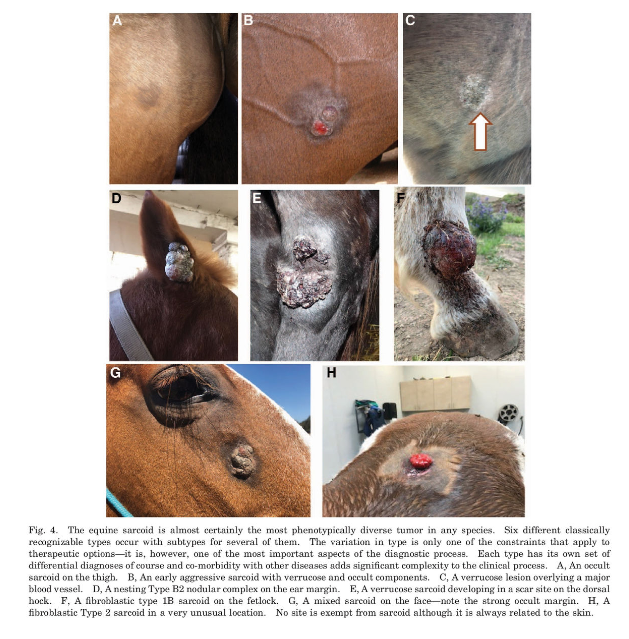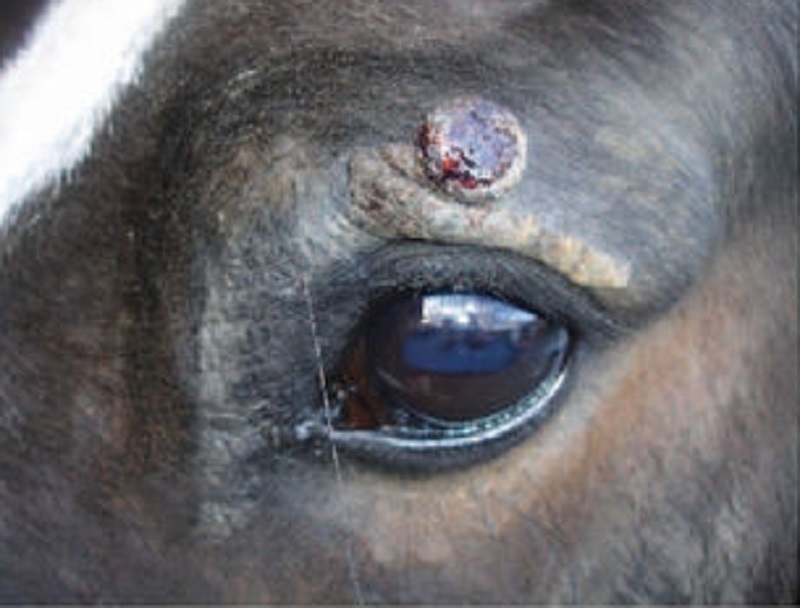Tuesdays with Tony
Very few things around here are uttered with the same hateful tone as the word sarcoid. My Docs do NOT like this tumor. They feel the same way about sarcoids, as I do about cold, rainy days. I’m lucky. The sun will come out tomorrow. The sarcoid may not go away tomorrow, or the next day, or the year after. Let me share a little Tony wisdom with you about this pesky, not quite cancer, but definitely a tumor, growth that horses get, and veterinarians hate.
What is it??
Putting on my overly dramatic professorial voice here: sarcoids are a neoplasm of fibroblast cells occurring at the level of the skin in anything equine, to include horses, donkeys, zebras, and all the crazy horse, donkey, zebra crosses that also exist. Now back to regular sarcastic Tony. This means it’s a tumor caused by the cells that give tissue toughness. Blast is science’s way of saying cell, and fibro is what these cells make. They make that tough fiber that keeps skin from tearing, tendons from ripping apart, lungs able to expand without breaking. You get the idea. Neoplasm technically means cancer, but the only good news about sarcoids is they don’t metastasize. That means little bits don’t break off to go form new tumors elsewhere on the body. If you see a horse with multiple sarcoids, each one of those is its own separate little hell creation, not a spawn.
Why? Oh, Why does my horse have Sarcoids?
It’s a reasonable question for so many of the things horses do, and get. It’s a reasonable question here too, but, as usual, the answer is complicated. There’s a cow wart virus called Bovine Papilloma Virus (BPV) that’s associated with many (but not all) sarcoids. That seems reasonable. I can see how horse skin could be like, eww get this cow wart virus out of here, and make something that looks like the warty, knobby, crusty thing sarcoids tend to look like. However, there’s some of these tumors that don’t have BPV associated with them. Being honest here, it’s a big old “they don’t know”. Here’s another big however: flies are implicated in the spread of BPV to uninfected horses! Need more reasons to have good fly control?? (I’ve written a few great blogs on this along with Dr. Erika Machtinger, known as The Other Erika around here, and there’s a podcast about it over at Straight From the Horse Doctor’s Mouth) One way doctors and scientists have determined flies are involved is the general location for sarcoids in the same areas flies like to hang out on horses. Scientists have also isolated way more BPV-carrying flies around horses with sarcoids than they have around non-sarcoidy horses. In other words, manage your flies. There is also (well, likely, anyway) a genetic predisposition to get more, and worse sarcoids, but this is so far beyond clear that my best answer is wait for more work on this topic.
The many faces of Sarcoids
This is where the fun starts. Sarcoids can have many, many different appearances, and the approach my Docs take will depend on what that appearance is. Sometimes they can’t even be sure it’s a sarcoid, based on appearance, so they do a biopsy. That biopsy has to go to one of a few equine skin specialists because sarcoids love to look like other things, even when being evaluated under a microscope!
So what are the sarcoid appearance options? Well there’s occult, verrucose, nodular, fibroblastic, mixed (my personal favorite), and malignant. Very often my Docs will take a wait-and-see approach to the occult and verrucose variety. These sarcoids are known to stay exactly as they are for years and years. They are also known to react poorly to negative stimuli, much like cats. Occult and verrucose also like to play together. They will even combine in one lesion. These guys can usually be described as flat for the most part. Don’t worry, I’ve included pictures for you.
Nodular are, not surprisingly, nobby, and have intact skin covering them. Fibroblastic are nobby, but with gnarly, warty, not intact skin covering them. Mixed are, well, mixes of the types. And finally, malignant. These guys are super aggressive, spreading, ugly, and very, very invasive. They like to grow on the sides of the face, the groin, and the elbows.
Pictures
These pictures were rather shamelessly borrowed from one of Dr. Knottenbelt’s excellent lectures on this topic at the recent American Association of Equine Practitioner’s meeting.
Die Sarcoid! Die!
Let’s talk about treatments. An important “rule” when it comes to treatments must be discussed here. When there are a whole lot of “treatments” available for a condition, it means science doesn’t have a good handle on the best treatment. It also means a whole lot of those “treatments” don’t do a darn thing, so you best check with one of my Docs before dropping a bunch of money on Dr. Google’s latest trend in sarcoid treatment, only to find out it’s nothing more than repackaged toothpaste. That’s a real example by the way.
For my Docs, treatments are generally two pronged in some way. Prong one involves removing as much of the tumor as possible. These include surgically removing it, freezing it, heating it, lasering it off, and sometimes even radiation. You know typical evil villain type stuff. Prong two involves getting after the remaining cells with chemicals. This is chemotherapy. There are topical and injectable versions. Choices here are based on location, type of sarcoid, and your horse’s willingness to let you do what needs done. There are also some really great, but very expensive options such as radiation therapy, brachytherapy, and photodynamic light therapy. These are only available at a few specialty hospitals around the world, but offer great ways to kill sarcoid cells in some very sensitive areas like around the eye.
There’s no way around it, sarcoids suck. Control your flies, and ask my Docs about lumps and bumps early is my very best cat advice.
Until next week,
~Tony
PS – If you would like to learn more about this topic, the humans just did a great podcast on this topic. Click here to learn more.
Tuesdays with Tony is the official blog of Tony the Clinic Cat at Springhill Equine Veterinary Clinic in Newberry, Florida. If you liked this blog, please subscribe below, and share it with your friends on social media! For more information, please call us at (352) 472-1620, visit our website at SpringhillEquine.com, or follow us on Facebook!
[jetpack_subscription_form title="Subscribe to Whinny's Wisdoms"]



